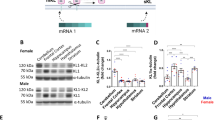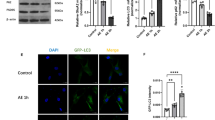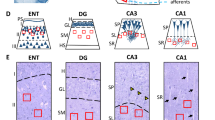Abstract
d-Serine, which is synthesized by the enzyme serine racemase (SR), is a co-agonist at the N-methyl-d-aspartate receptor (NMDAR). Crucial to an understanding of the signaling functions of d-serine is defining the sites responsible for its synthesis and release. In order to quantify the contributions of astrocytes and neurons to SR and d-serine localization, we used recombinant DNA techniques to effect cell type selective suppression of SR expression in astrocytes (aSRCKO) and in forebrain glutamatergic neurons (nSRCKO). The majority of SR is expressed in neurons: SR expression was reduced by ~65% in nSRCKO cerebral cortex and hippocampus, but only ~15% in aSRCKO as quantified by western blots. In contrast, nSRCKO is associated with only modest decreases in d-serine levels as quantified by HPLC, whereas d-serine levels were unaffected in aSRCKO mice. Liver expression of SR was increased by 35% in the nSRCKO, suggesting a role for peripheral SR in the maintenance of brain d-serine. Electrophysiologic studies of long-term potentiation (LTP) at the Schaffer collateral–CA1 pyramidal neuron synapse revealed no alterations in the aSRCKO mice versus wild-type. LTP induced by a single tetanic stimulus was reduced by nearly 70% in the nSRCKO mice. Furthermore, the mini-excitatory post-synaptic currents mediated by NMDA receptors but not by AMPA receptors were significantly reduced in nSRCKO mice. Our findings indicate that in forebrain, where d-serine appears to be the endogenous co-agonist at NMDA receptors, SR is predominantly expressed in glutamatergic neurons, and co-release of glutamate and d-serine is required for optimal activation of post-synaptic NMDA receptors.







Similar content being viewed by others
Abbreviations
- NMDA:
-
N-methyl-d-aspartate
- SR:
-
Serine racemase
- aSRCKO:
-
Astrocyte-specific SR conditional knockout
- nSRCKO:
-
Neuron-specific SR conditional knockout
- GFAP:
-
Glial fibrillary acidic protein
- TAM:
-
Tamoxifen
- CaMKIIα:
-
α-Subunit of Ca2+/calmodulin-dependent kinase II
- WT:
-
Wild-type
- HPLC:
-
High-performance liquid chromatography
References
Asztely F, Erdemli G, Kullmann DM (1997) Extrasynaptic glutamate spillover in the hippocampus: dependence on temperature and the role of active glutamate uptake. Neuron 18:281–293
Basu AC, Tsai GE, Ma CL, Ehmsen JT, Mustafa AK, Han L, Jiang ZI, Benneyworth MA, Froimowitz MP, Lange N, Snyder SH, Bergeron R, Coyle JT (2009) Targeted disruption of serine racemase affects glutamatergic neurotransmission and behavior. Mol Psychiatry 14:719–727
Boehning D, Snyder SH (2003) Novel neural modulators. Annu Rev Neurosci 26:105–131
Casper KB, Jones K, McCarthy KD (2007) Characterization of astrocyte-specific conditional knockouts. Genesis 45:292–299
D’Aniello A, D’Onofrio G, Pischetola M, D’Aniello G, Vetere A, Petrucelli L, Fisher GH (1993) Biological role of d-amino acid oxidase and d-aspartate oxidase. Effects of d-amino acids. J Biol Chem 268:26941–26949
Ding X, Ma N, Nagahama M, Yamada K, Semba R (2011) Localization of d-serine and serine racemase in neurons and neuroglias in mouse brain. Neurol Sci 32(2):263–267
Fadda E, Danysz W, Wroblewski JT, Costa E (1988) Glycine and d-serine increase the affinity of N-methyl-d-aspartate sensitive glutamate binding sites in rat brain synaptic membranes. Neuropharmacology 27:1183–1185
Foltyn VN, Bendikov I, De Miranda J, Panizzutti R, Dumin E, Shleper M, Li P, Toney MD, Kartvelishvily E, Wolosker H (2005) Serine racemase modulates intracellular d-serine levels through an alpha, beta-elimination activity. J Biol Chem 280:1754–1763
Glowinski J, Iversen LL (1966) Regional studies of catecholamines in the rat brain. I. The disposition of [3H]norepinephrine, [3H]dopamine and [3H]dopa in various regions of the brain. J Neurochem 13:655–669
Hashimoto A, Chiba S (2004) Effect of systemic administration of d-serine on the levels of d- and l-serine in several brain areas and periphery of rat. Eur J Pharmacol 495:153–158
Hashimoto A, Nishikawa T, Oka T, Takahashi K, Hayashi T (1992) Determination of free amino acid enantiomers in rat brain and serum by high-performance liquid chromatography after derivatization with N-tert-butyloxycarbonyl-l-cysteine and o-phthaldialdehyde. J Chromatogr 582:41–48
Hashimoto A, Nishikawa T, Oka T, Takahashi K (1993) Endogenous d-serine in rat brain: N-methyl-d-aspartate receptor-related distribution and aging. J Neurochem 60:783–786
Hashimoto A, Oka T, Nishikawa T (1995) Anatomical distribution and postnatal changes in endogenous free d-aspartate and d-serine in rat brain and periphery. Eur J Neurosci 7:1657–1663
Henneberger C, Papouin T, Oliet SH, Rusakov DA (2010) Long-term potentiation depends on release of d-serine from astrocytes. Nature 463:232–236
Kartvelishvily E, Shleper M, Balan L, Dumin E, Wolosker H (2006) Neuron-derived d-serine release provides a novel means to activate N-methyl-d-aspartate receptors. J Biol Chem 281:14151–14162
Li Y, Krupa B, Kang JS, Bolshakov VY, Liu G (2009) Glycine site of NMDA receptor serves as a spatiotemporal detector of synaptic activity patterns. J Neurophysiol 102:578–589
Miya K, Inoue R, Takata Y, Abe M, Natsume R, Sakimura K, Hongou K, Miyawaki T, Mori H (2008) Serine racemase is predominantly localized in neurons in mouse brain. J Comp Neurol 510:641–654
Mothet JP, Parent AT, Wolosker H, Brady RO Jr, Linden DJ, Ferris CD, Rogawski MA, Snyder SH (2000) d-Serine is an endogenous ligand for the glycine site of the N-methyl-d-aspartate receptor. Proc Natl Acad Sci USA 97:4926–4931
Mothet JP, Pollegioni L, Ouanounou G, Martineau M, Fossier P, Baux G (2005) Glutamate receptor activation triggers a calcium-dependent and SNARE protein-dependent release of the gliotransmitter d-serine. Proc Natl Acad Sci USA 102:5606–5611
Panatier A, Theodosis DT, Mothet JP, Touquet B, Pollegioni L, Poulain DA, Oliet SH (2006) Glia-derived d-serine controls NMDA receptor activity and synaptic memory. Cell 125:775–784
Patel J, Zinkand WC, Thompson C, Keith R, Salama A (1990) Role of glycine in the N-methyl-d-aspartate-mediated neuronal cytotoxicity. J Neurochem 54:849–854
Rosenberg D, Kartvelishvily E, Shleper M, Klinker CM, Bowser MT, Wolosker H (2010) Neuronal release of d-serine: a physiological pathway controlling extracellular d-serine concentration. FASEB J 24:2951–2961
Schell MJ, Molliver ME, Snyder SH (1995) d-Serine, an endogenous synaptic modulator: localization to astrocytes and glutamate-stimulated release. Proc Natl Acad Sci USA 92:3948–3952
Schweizer C, Balsiger S, Bluethmann H, Mansuy IM, Fritschy JM, Mohler H, Luscher B (2003) The gamma 2 subunit of GABA(A) receptors is required for maintenance of receptors at mature synapses. Mol Cell Neurosci 24:442–450
Shin RM, Tsvetkov E, Bolshakov VY (2006) Spatiotemporal asymmetry of associative synaptic plasticity in fear conditioning pathways. Neuron 52:883–896
Wolosker H (2011) Serine racemase and the serine shuttle between neurons and astrocytes. Biochim Biophys Acta 1814(11):1558–1566
Wolosker H, Blackshaw S, Snyder SH (1999) Serine racemase: a glial enzyme synthesizing d-serine to regulate glutamate-N-methyl-d-aspartate neurotransmission. Proc Natl Acad Sci USA 96:13409–13414
Wolosker H, Dumin E, Balan L, Foltyn VN (2008) d-Amino acids in the brain: d-serine in neurotransmission and neurodegeneration. FEBS J 275:3514–3526
Zhang Y, Barres BA (2010) Astrocyte heterogeneity: an underappreciated topic in neurobiology. Curr Opin Neurobiol 20:588–594
Zucker RS, Regehr WG (2002) Short-term synaptic plasticity. Annu Rev Physiol 64:355–405
Acknowledgments
This work was funded by NIH R01MH051290 and P50MH0G0450. We thank Jiamin Feng and Alexander S. Roseman for animal colony maintenance and genotyping. Cre transgenic mouse strains were generously provided by Yu Yamaguchi and Ken D. McCarthy.
Author information
Authors and Affiliations
Corresponding author
Rights and permissions
About this article
Cite this article
Benneyworth, M.A., Li, Y., Basu, A.C. et al. Cell Selective Conditional Null Mutations of Serine Racemase Demonstrate a Predominate Localization in Cortical Glutamatergic Neurons. Cell Mol Neurobiol 32, 613–624 (2012). https://doi.org/10.1007/s10571-012-9808-4
Received:
Accepted:
Published:
Issue Date:
DOI: https://doi.org/10.1007/s10571-012-9808-4




